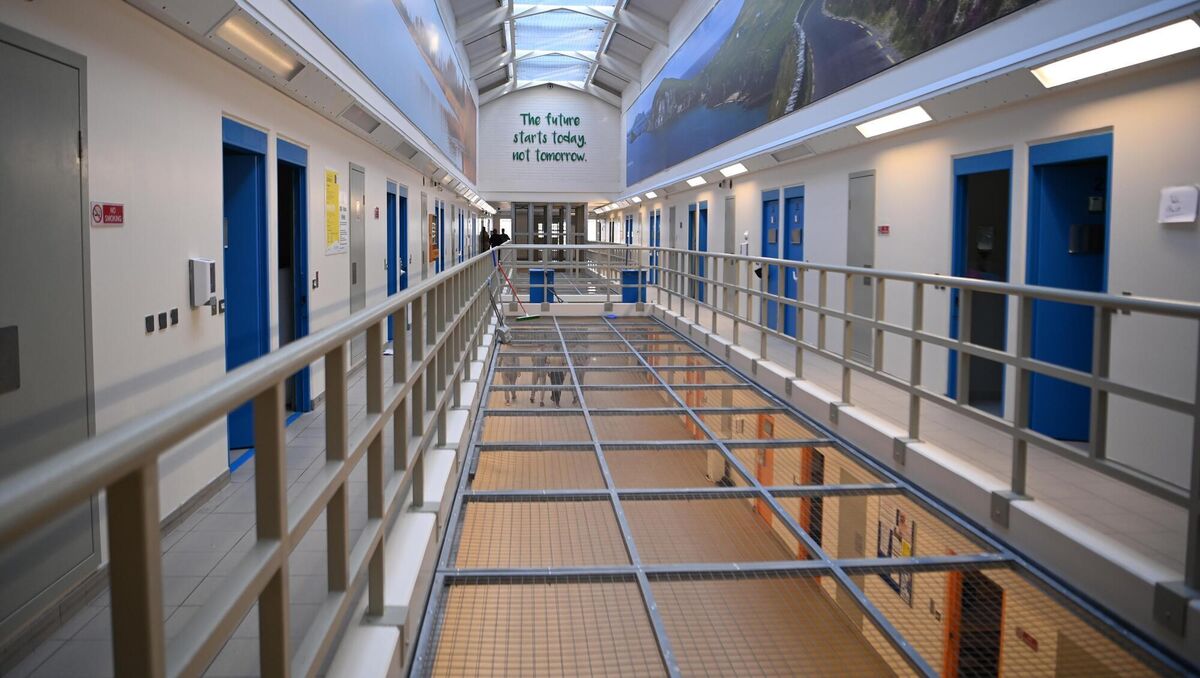'No doubt' that overcrowding is a factor in 50% rise of prison deaths, inspector says

A cell in Mountjoy Prison in February with a mattress on the floor to accomodate a second prisoner because of overcrowding. The Office of the Inspector of Prisons said contributing factors to the rise in prison deaths 'include overcrowding, mental health pressures, and gaps in the provision of healthcare services'. Photo: Moya Nolan
The prison inspector has expressed grave concern at a 50% increase in deaths in the country’s jails in 2024 — and pointed to the worsening overcrowding crisis and mental health pressures as factors.
In his 2024 annual report, Mark Kelly said that a significant number of prisoners are being held in conditions that could only be described as “inhumane and degrading”.
The Inspector of Prisons called for “immediate action” from the Government to address the “ongoing crisis” in the system.
The annual report of the Office of the Inspector of Prisons (OIP) said there were 31 deaths in prison custody in 2024.
“Sadly, this was the largest number of deaths to be investigated in any year since the Inspectorate commenced investigating deaths in January 2012,” the report said.
“This represents a significant increase on 2023 when a total of 20 deaths fell within the scope for investigation.”
The OIP said “contributing factors include overcrowding, mental health pressures, and gaps in the provision of healthcare services”.
The report shows that of the 31 deaths, 19 occurred in prison custody, four happened in hospital and seven happened within one month of getting out on temporary release (TR).
A breakdown between the relevant prisons show:
- Cloverhill Remand Prison: Five deaths – four of them in prison and one in hospital;
- Cork Prison: Five deaths – two of them in prison, one in hospital and two within one month of getting TR;
- Loughlan House Open Prison: One death, while unlawfully at large;
- Midlands Prison: Nine deaths – six in prison, two in hospital and one on TR;
- Portlaoise Prison: One death, in prison;
- Wheatfield Prison: Five deaths, three in prison and two on TR.
Mr Kelly said there was “no doubt” that overcrowding played a part in these deaths, as well as poor risk assessment on committal to prison and supervision of prisoners suspected of internally concealing contraband.
He said: “We have found that the scourge of overcrowding continues to afflict almost every prison in Ireland, and the situation has worsened significantly over the last year.”
He said, in March 2023, the prison population had exceeded 4,900 people, a figure he then characterised as “many hundred in excess of the number that can be safely accommodated”.
The inspector said that at the time of submitting the annual report, last March, numbers were nearly 5,300 and that “very many prisoners are being held in conditions that can only be described as inhumane and degrading”.
As of this Wednesday, prison numbers stand at 5,628, while the maximum possible capacity of the system is 4,702.
Mr Kelly said:
“Currently, Ireland’s prison population exceeds more than 5,600, of whom almost 500 are being obliged to sleep on mattresses on the floor. In Ireland, in 2025, a significant number of people in prison are being held in conditions that can only be described as inhumane and degrading.
“These are clear symptoms of a prison system that has breached its capacity. No comparable jurisdiction has ever succeeded in building its way out of overcrowding, and immediate action is required, at the highest political levels, to address this ongoing crisis."
The inspector reiterated his call for a maximum “enforceable” ceiling on the number of people that can be safely held in each prison: “It is no longer credible to respond to these concerns with rote answers referencing future increases in the capacity of the prison estate. No comparable jurisdiction has ever succeeded in building itself out of overcrowding.”
Justice minister Jim O’Callaghan has said that, since January 2022, capacity across the prison estate has been increased by more than 300 new spaces, with 126 delivered in 2024 and 40 delivered to date in 2025, with plans to deliver a further 101 additional spaces by the end this year.

He has pointed to €495m additional capital funding for the Irish Prison Service between now and 2030 as part of the National Development Plan review.
This promises to build 1,500 spaces, including projects planned at Castlerea, Cloverhill, Mountjoy, Portlaoise, Wheatfield, Midlands, Dóchas, and the Old Cork Prison site.
Most of these projects will only begin to come on stream towards the end of the 2025-2030 NDP period. It is not clear what prison numbers will reach by then.
The NDP provision will also provide funding to allow work to start on the development of the prison at Thornton Hall.
Minister O’Callaghan has also promised an expansion in the capacity of the Probation Service to enable the courts divert more people from prison to community sanctions. He has said proposed legal provisions will support that plan.
Inspections completed in 2024 found:
Running at 98% capacity when visited:
- Relationships: The Inspectorate was pleased to note that relationships within the prison were positive and respectful. Many prisoners told the OIP that they were treated fairly by prison staff.
- Education: The school was a highly valued resource within the prison and was well attended by people in the prison. There was evidence of good integration with other services within the prison, such as work training.
- Sentence Management: The prison had significantly strengthened and improved its delivery of Integrated Sentence Management. Additional resources were in place, and sentence planning practices were individualised, targeted, and benefitted from the collaborative input of services like work training, the school, and the Probation Service.
- Overcrowding/inadequate living space: The doubling of cells, which were already small, resulted in many prisoners having less than the minimum 4m² of living space per person, as recommended by the Council of Europe’s European Committee for the Prevention of Torture (CPT).
- Inadequate sanitation: Toilets in cells were not partitioned, and some lacked lids. Beds on the lower bunk were in close proximity to the open toilets, with observed distances as low as 40cm and 60cm.
- Safety Risk: Bunk bed ladders were often inaccessible due to a lack of space, requiring men to climb on furniture to reach the top bunk.
Midlands Prison was operating at 112% capacity at the time of inspection, with major concerns around overcrowding and restricted regimes:
- Inhuman and degrading conditions: Overcrowding led to an average of 31 men sleeping on mattresses on the floors during the inspection, in conditions described as degrading. Occupants often ate meals on the floor next to unpartitioned toilets.
- Restricted regimes/solitary confinement: Some prisoners on restricted regimes were offered only 30 minutes of daily yard time and 30 minutes for shower/cell cleaning. Many declined the yard time, meaning they could spend 23.5 hours daily in their cells, which was observed to impact their mental health. There was limited planning to reduce the number of men on a restricted regime.
- Use of refractory clothing: The practice of systematically placing prisoners in refractory clothing (naked under light ponchos) in Close Supervision Cells (CSCs) continued, despite previous national and international recommendations to end this practice.
- Health and Safety: Only one night nurse was on duty for a population of 986 men, which was deemed a serious concern and insufficient to respond to medical emergencies.
- Lack of therapeutic engagement: The NVRU was found to be predominantly security-focused, with limited meaningful therapeutic engagement for people living there. For example, 50% had no engagement with Psychology Services.
- Lack of progression: There appeared to be no structured progression plans in place for men in the unit.
The prison was operating at 144% capacity due to severe overcrowding, despite being newly designed, which undermined its intended trauma-informed ethos:
- Accommodation: The standard of accommodation in some parts of the prison was excellent.
- Healthcare Delivery: Healthcare delivery at the prison was generally very good. However, the Inspectorate noted that primary healthcare services would benefit from additional nursing cover.
- Structured Temporary Release: The introduction of the Structured Temporary Release Programme was a positive development and is intended to provide greater support to women on their release to the community.
- Overcrowding and safety: Overcrowding was impacting the physical, psychological, and emotional safety of women. Rooms intended for single occupancy were doubled with bunk/camp beds.
- Trauma-informed ethos: Deficits in provision were at odds with a trauma-informed environment, including the lack of requisite items in independent living areas (e.g., cookware in kitchenettes), and limited choice and activities for women.
- Access to information: Women did not receive information booklets on committal, and there was little written information on rules, regimes, or accessing support services, affecting trust.
- Mental health: 66% of women surveyed reported that a lack of adequate support for mental health was the biggest issue, and 87% disagreed that the prison was equipped to support people with mental health issues.
- Complaints system: 54% of women surveyed did not feel safe making a complaint, mirroring concerns across the estate.
Overcrowding remained the primary issue, with conditions deteriorating since the previous inspection:
- Severe overcrowding and degrading conditions: 34% of the population (168 of 491) were accommodated four-to-a-cell in cells designed for triple occupancy. The number of men sleeping on mattresses on the floors had drastically increased, ranging from 51 to 68 during the follow-up inspection. The vast majority of people were found to be living in degrading conditions.
- Sub-standard living conditions: Toilets were not fully partitioned in multi-occupancy cells. Some men had to stand while eating meals due to insufficient chairs. High temperatures of 25-26 degrees Celsius were recorded in winter with limited ventilation.
- Access to basic sanitation: The limited time allocation for showers (maximum one hour daily per landing) did not permit all men on larger landings access to a daily shower.
- Inappropriate detention: The prison accommodated men with serious mental illness who should be diverted to appropriate therapeutic settings, as well as immigration detainees, whom the OIP believes should not be held in prison.
- Safety risk: Prison officers had placed tape and a card over the cell alarm system to mute calls on various landings, which is a serious safety concern.










